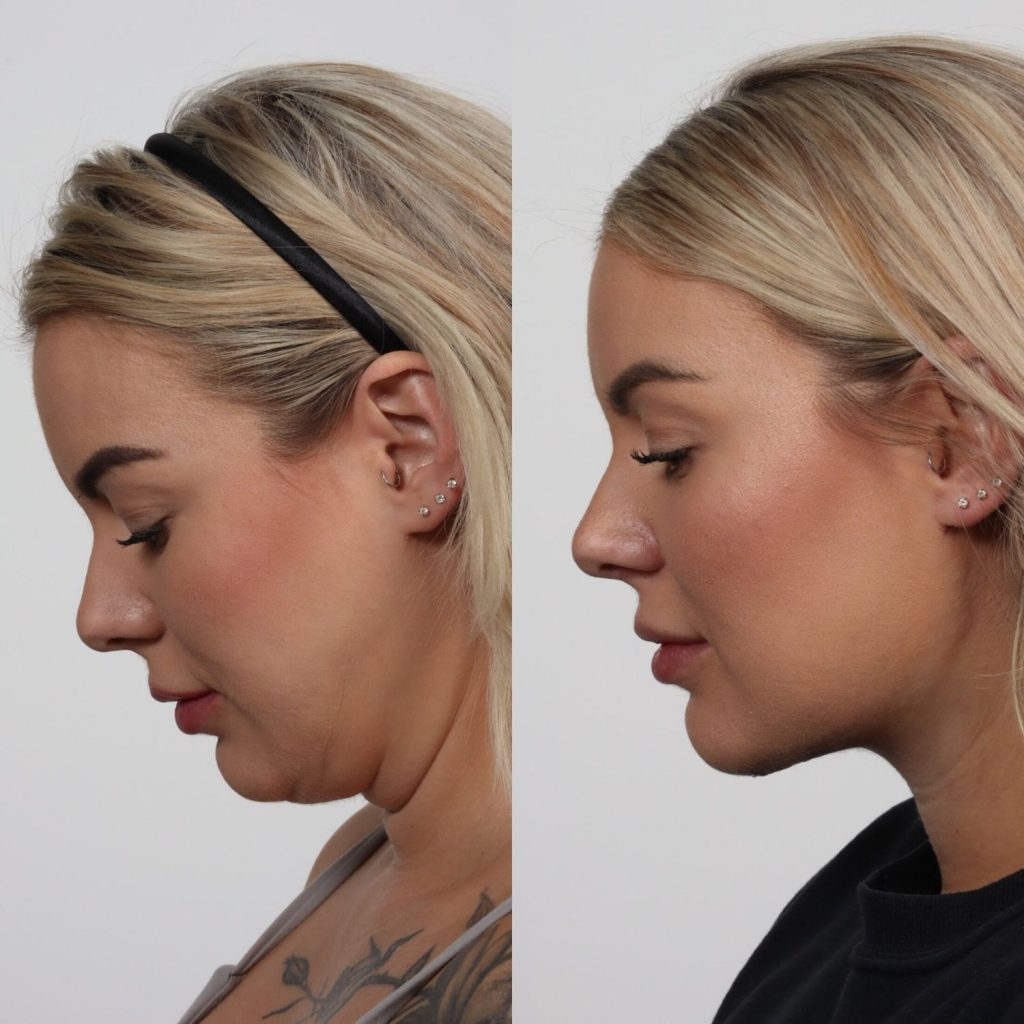Deep neck lift
A deep neck lift is a surgical procedure designed to improve the contour of the neck and jawline. It is a more comprehensive approach than a traditional neck lift, addressing deeper anatomical structures to achieve significant and long-lasting results. Here’s a detailed guide covering various aspects of a deep neck lift:
What is a Deep Neck Lift?
A deep neck lift is a specialized surgical technique aimed at enhancing the definition of the jawline and neck. It is particularly beneficial for individuals who have a naturally full or heavy neck, a condition that can start as early as puberty. This fullness is often due to anatomical factors rather than aging.

Anatomical Factors Contributing to Neck Fullness
Several anatomical factors can contribute to a poorly defined neck and jawline:
- Small Jaw or Weak Chin: Sometimes caused by earlier orthodontic treatments that limit jaw growth.
- Subplatysmal Fat: Fat located deep under the neck muscles, which cannot be addressed by simple liposuction.
- Enlarged or Descended Submandibular Glands: These glands can protrude into the neck, creating visible fullness.
- Prominent Digastric Muscles: These muscles can overdevelop, contributing to a bulky appearance under the chin.
- Lower Positioned Voicebox: Adds to the fullness of the neck.
Traditional Neck Lift vs. Deep Neck Lift
While both procedures aim to rejuvenate the neck, they differ in their techniques and the issues they address:
- Traditional Neck Lift: This typically addresses sagging neck tissues and may involve limited liposuction. It often combines with a facelift and involves tightening the platysma neck muscles through an under-chin incision.
- Deep Neck Lift: This is a more comprehensive approach that focuses on reducing volume and refining the contour of the neck rather than just tightening the skin. It is essential for those with a heavy neck.
Who is a Good Candidate for a Deep Neck Lift?
Ideal candidates for a deep neck lift include:
- Individuals with a « full » or « heavy » neck from a young age.
- Those with specific anatomical factors contributing to neck fullness, such as subplatysmal fat, enlarged submandibular glands, or prominent digastric muscles.
- People with good skin elasticity.
- Those who desire a more defined jawline and neck contour.
- Generally, the neck lift works best in patients who retain some elasticity in the neck skin. It does not remove excess skin so it is best for patients with neck laxity without jowling and can be coupled with neck liposuction.
Procedural Steps in a Deep Neck Lift
A deep neck lift involves several intricate steps to achieve the desired aesthetic outcome:
- Liposuction: Targets the fat just below the skin for initial contouring.
- Skin and Muscle Work: An incision is made to lift the skin and access the platysma muscles, which are then adjusted to remove excess fat that liposuction cannot reach.
- Gland and Muscle Modification: Enlarged or descended parts of the submandibular glands are trimmed. The digastric muscles under the chin, often responsible for bulging, are reduced and repositioned. Additional maneuvers such as horizontal fasciotomy and transverse platysmal myotomy, can be performed to further improve the sharpness of the cervicomental angle.
In contrast, a Deep Neck Lift often avoids the latter incisions. Usually, a Deep Neck Lift requires only one incision carefully concealed in the crease underneath the chin.
Recovery Insights
Recovery from a deep neck lift is a gradual process, with immediate visible improvements and some typical post-surgical experiences:
- Initial Discomfort: It is common to feel sore as the deeper structures of the neck have been adjusted.
- Swelling and Bruising: These effects are particularly noticeable following liposuction but will diminish over several weeks.
- Sensory Changes: Temporary numbness in the neck skin can occur due to the elevation during surgery.
- Facial Movements: There might be a temporary weakness in the lower lip, which generally recovers within 4-6 weeks.
- Following surgery, patients are sent home wearing a compressive dressing for a few days. For the following 1-2 weeks a chin strap is worn to protect incision sites and allow the neck tissue to heal. Most people feel comfortable being out in public after 2 weeks.
Benefits of a Deep Plane Face Lift over a Traditional Face Lift
- A more natural-looking rejuvenation.
- Longer lasting results of 10-15 years compared to 7-10 years.
MIDS Neck Lift™
The MIDS Neck Lift™ is a neck sculpting and tightening procedure that uses a small, hidden incision to treat multiple layers of the neck. Unlike regular neck or under-chin liposuction that only removes surface fat, the MIDS Neck Lift is a more comprehensive procedure that also addresses deeper layers. The neck has several layers: the outer layer (skin and surface fat), the platysma muscle (a thin muscle covering most of the front of the neck), and deeper structures (like deeper fat, digastric muscles, and submandibular glands). The platysma muscle can sag and the deeper structures can add fullness to the neck, varying from person to.
The MIDS Neck Lift™ in practice
The MIDS Neck Lift™ (Minimal Incision Deep Subplatysmal) is a specific type of neck lift procedure designed to address multiple layers of the neck through a small, hidden incision. It’s marketed as a more comprehensive approach compared to standard neck liposuction or traditional neck lifts.
Here’s a breakdown of the key aspects:
Core Principles and Technique:
- Multi-Layer Treatment: Unlike procedures that only focus on surface fat (like liposuction), the MIDS Neck Lift™ aims to treat the outer layer (skin and surface fat), the platysma muscle, and deeper structures like deeper fat pads, digastric muscles, and submandibular glands.
- Small Incision: The procedure is performed through a small incision, typically hidden in the natural crease under the chin. This is intended to minimize visible scarring.
- Subplatysmal Approach: The « deep subplatysmal » part of the name indicates that the surgeon works beneath the platysma muscle to access and modify the deeper structures of the neck. This allows for more significant contouring and reshaping.
- Addressing Underlying Causes: The MIDS Neck Lift™ aims to correct underlying anatomical issues that contribute to a poorly defined neck, such as sagging platysma muscles, excess subplatysmal fat, or prominent digastric muscles.
What it addresses:
- Excess fat under the chin and in the neck
- Sagging platysma muscles
- Prominent digastric muscles
- Enlarged submandibular glands
How it differs from other neck procedures:
- Traditional Neck Lift: Traditional neck lifts often involve a larger incision and focus primarily on tightening the skin and platysma muscle. The MIDS Neck Lift™ is designed to be less invasive while addressing deeper anatomical issues.
- Liposuction: Liposuction alone only removes surface fat and doesn’t address muscle laxity or deeper fat pads.
- Thread Lift: Thread lifts provide a temporary lift by using threads to lift the skin.
Recovery:
- As it is less invasive, recovery time is shorter than a traditional neck lift.
Cost:
Unfortunately, providing a precise cost estimate for the MIDS Neck Lift™ is difficult without a consultation. Surgical fees can vary widely based on:
- Surgeon’s experience and expertise: Highly experienced surgeons typically charge more.
- Geographic location: Costs tend to be higher in major metropolitan areas.
- Anesthesia fees: The type of anesthesia used will affect the cost.
- Facility fees: The cost of the operating room and related facilities.
- Additional procedures: If you combine the MIDS Neck Lift™ with other procedures (like chin augmentation), the overall cost will increase.

Undergoing a deep neck lift, like any surgical procedure, carries potential risks and complications. It’s essential to be aware of these before making a decision. Here’s a breakdown of the possible issues:
General Surgical Risks:
- Anesthesia Risks: Reactions to anesthesia can occur.
- Bleeding (Hematoma): Bleeding under the skin can lead to a hematoma, which may require drainage.
- Infection: Infection is a possibility with any surgery.
- Deep Vein Thrombosis (DVT): A rare risk where blood clots can form, potentially leading to cardiac or pulmonary complications.
Specific Neck Lift Risks:
- Nerve Injury: Nerve damage can cause numbness, tingling, changes in skin sensation, or even weakness of the lower lip.
- Scarring: Visible, thick, or uneven scars can occur.
- Poor Wound Healing: This can be more common in smokers or those with underlying health conditions.
- Skin Loss: In rare cases, skin loss (necrosis) can occur.
- Fluid Accumulation: Fluid can accumulate, leading to a hematoma.
- Prolonged Swelling (Edema): Swelling can persist for an extended period.
- Skin Irregularities and Discoloration: This includes pigmentation or hypo-pigmentation.
- Suture Issues: Sutures may surface, causing irritation and requiring removal.
- Hair Loss: Temporary or permanent hair loss can occur along incision lines.
- Facial Asymmetry: Unevenness in facial appearance can result.
- Unfavorable Hairline Changes: The hairline can be altered due to the surgery.
- Ear Lobe distortion: Earlobes can be pulled inferiorly during healing.
- Hyperpigmentation and hypervascularity: Skin may darken or develop increased blood vessels.
- Wound dehiscence: Incisions may open during healing.
Other Considerations:
- Dissatisfactory Results: There’s a possibility of being unhappy with the outcome, potentially requiring revision surgery.
- Persistent Pain: You may experience ongoing pain or discomfort.
How long is the typical recovery time and what is the downtime?
The recovery time and downtime after a deep neck lift can vary depending on the extent of the surgery, individual healing rates, and the specific techniques used. However, here’s a general overview:
Typical Recovery Timeline:
- First Week:
- Expect swelling, bruising, and discomfort. Pain medication will be prescribed.
- A compression bandage or dressing is typically worn to minimize swelling and support the tissues.
- Drains may be placed to remove excess fluid accumulation.
- Limit physical activity and keep your head elevated.
- 1-2 Weeks:
- Swelling and bruising will begin to subside.
- Sutures are usually removed within this timeframe.
- You can gradually resume light activities, but avoid strenuous exercise.
- You may still experience some numbness or tightness in the neck.
- 2-4 Weeks:
- Most of the visible swelling and bruising should resolve.
- You can gradually return to more normal activities, including exercise, as tolerated.
- The neck will continue to heal and refine its contour.
- Several Months:
- The final results of the deep neck lift will become more apparent as the tissues fully settle and the swelling completely resolves.
- Scarring will continue to fade over time.
- Numbness or altered sensation may persist for several months.
Downtime:
- Initial Downtime (1-2 Weeks): This is the period when you’ll need to take time off from work, social activities, and most daily routines. You’ll likely be focused on managing pain, swelling, and following your surgeon’s instructions.
- Reduced Activity (2-4 Weeks): While you can gradually resume some activities, you’ll still need to avoid strenuous exercise and heavy lifting. You may also want to limit social engagements until the swelling and bruising have significantly improved.
- Return to Normal (4-6 Weeks): Most people can return to their normal routines within 4-6 weeks, although some residual swelling or numbness may persist for longer.
Factors Affecting Recovery:
- Extent of Surgery: More extensive procedures will generally require a longer recovery period.
- Individual Healing: Healing rates vary from person to person.
- Age: Older individuals may take longer to heal.
- Health Conditions: Underlying health conditions can affect recovery.
- Smoking: Smoking can impair wound healing and increase the risk of complications.
- Following Instructions: Adhering to your surgeon’s post-operative instructions is crucial for a smooth recovery.
Important Considerations:
- It’s essential to have realistic expectations about the recovery process.
- Be patient and allow your body the time it needs to heal.
- Follow your surgeon’s instructions carefully.
- Attend all follow-up appointments.
- Contact your surgeon if you experience any concerning symptoms, such as excessive bleeding, signs of infection, or severe pain.

